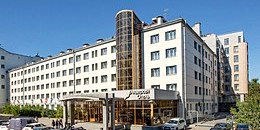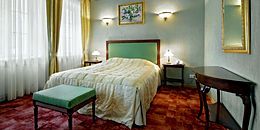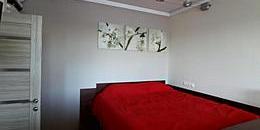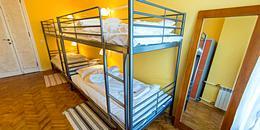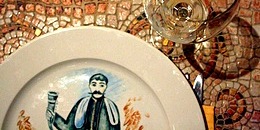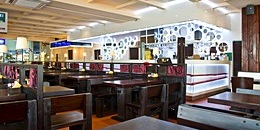Kamennoostrovsky Prospekt
One of the most beautiful streets in St. Petersburg, and one of the busiest both day and night, Kamennoostrovsky Prospekt is the central thoroughfare of the Petrograd Side, linking the centre of the city with its northwestern boroughs. The avenue has numerous attractions, most of them fine examples of art nouveau - more specifically "northern moderne" - architecture, to such an extent that Kamennoostrovsky Prospekt has been described as a "museum of moderne".

Like all St. Petersburg's major streets, Kamennoostrovsky was laid out in stages. The first, Ruzheynaya Ulitsa, was constructed in 1712 and connected Troitskaya Ploshchad with the Armory Yard (Oruzheyny Dvor), now Avstriyskaya Ploshchad. The other sections of the modern avenue were called Monetcheskaya Ulitsa and Yazykovaya Ulitsa. Right up until the middle of the 19th century, the area that the modern avenue crosses was still a fashionable area for dachas, most of which were one- or two-storey wooden buildings with large gardens. The last of these suburban villas to survive is the Gromov House, in the Lopukhinsky Garden and the northern end of the avenue.

In 1804, the road was extended to Kamenny Ostrov, paved with cobblestones, and fitted with pavements and gutters. One of the first stone buildings to appear was the prestigious Aleksandrovsky Lycee, built 1831-1834 by Ludwig Charlemagne in late neoclassical style. Around the same time, two attractive squares - now Avstriyskaya Ploshchad and Ploshchad Lva Tolstogo - were laid out along the avenue. The area became the home of army officers, merchants, shopkeepers, and the poorer gentry. In 1867, the road was given the name Kamennoostrovsky Prospekt.

In the second half of the 19th century, streetcars began to run along the avenue, and the area was equipped with running water and sewers. At the turn of the century, the area blossomed thanks to the opening of the Trinity Bridge (Troitsky Most), which finally connected the island properly to the centre of the city. Serendipitously, this was exactly the moment when style moderne came into fashion, along with several new construction techniques, and within 15 years this graceful style, especially adapted to the rigours of the northern climate, had come to dominate the area, giving the Petrograd Side its own, specifically Nordic atmosphere. Of particular note are the mansion of Sergey Witte, the Lidval Building, the Rozenshtein Apartment Building, the House of the Emir of Bukhara, the Voeykova Building, the Benois Building, the Zimmerman Apartment Building, and the fine collection of residential buildings on Avstriyskaya Ploshchad. Thanks to this wealth of architectural treasures, the local press often referred to Kamennoostrovsky Prospekt as "the Champs Elysees of St. Petersburg".

The avenue became home to many of St. Petersburg's great and good, including financiers, industrialists, ministers, writers, composers, and Petesrburg aristocrats. Among them were the finance minister Sergey Witte, the writer Leonid Andreev, the neurologist Vladimir Bekhterev, the entomologist and explorer Grigory Grumm-Grzhumaylo, and Said Mir Mohammed Alim Khan, Emir of Bukhara. This tradition continued after the Revolution, with local Party boss Sergey Kirov, the Nobel prize-winning physicist Pyotr Kapitsa, composer Dmitry Shostakovitch, and the beloved comedian, actor and director Arkady Raikin all residents of the street at different times.
Special mention should also be given to the small but charming green spaces that punctuate the avenue's architecture. Kamennoostrovsky Prospekt begins between the Alekansdrovsky Park and Troitskaya Ploshchad, an attractive green square, and ends at the Lopukhinsky Garden and the Kamennoostrovsky Palace Park, with several other squares and gardens along the way.
During the Soviet era, the avenue retained its importance. New buildings appeared, by then in constructivist style, including the Lensoviet Palace of Culture, the House of Arts Workers, the House of Soviet Trade Workers, and the residential building of the Institute of Experimental Medicine. For some years after the Revolution, the avenue was given the romantic name "Avenue of Red Dawns", before being renamed in honour of Sergey Kirov, the popular Leningrad Party boss, who died in mysterious circumstances in 1934. The avenue only got its historic name back in 1991. Thanks to its status as a "Government Highway", leading to several official residences on Kamenny Ostrov, the avenue has always been carefully maintained, and continues to delight guests with its highly varied but beautifully harmonious architecture.

| Metro stations: | Gorkovskaya, Petrogradskaya |
|---|---|
| Best walking route: | Nearly the whole avenue, from Ulitsa Kuybysheva to Kamenny Ostrov (2.9km). |
| What's here? | Sergey Witte Mansion, Lidval Building, Rozenshtein Apartment Building, House of the Emir of Bukhara, Voeykova Building, Benois Building, Shvedersky Building, Mansion of the merchant Igel, Zimmerman Apartment Building, Lensoviet Palace of Culture, Aleksandrinsky Lycee, Church of the birth of John the Baptist |
| What's nearby? | Troitskaya Ploshchad, Trinity Bridge (Troitsky Most), Kronversky Prospekt, Avstriyskaya Ploshchad, Bolshaya Monetnaya Ulitsa, Bolshaya Pushkarskaya Ulitsa, Bolshoy Prospekt Petrograd Side, Ploshchad Lva Tolstogo, Ploshchad Shevchenko, Silin Bridge, Ulitsa Professora Popova, Pesochnaya Naberezhnaya, Kamennoostrovsky Bridge, Malaya Nevka Embankment (Naberezhnaya Maloy Nevki), Bolshaya Nevka Embankment (Naberezhnaya Bolshoy Nevki), Ushakovsky Bridge, Kamennoostrovsky Palace, Karpovka River, Bolshaya Nevka River, Malaya Nevka River, Neva, Peter and Paul Fortress, Aleksandrovsky Park, Lopukhinsky Garden, Petrovskaya Naberezhnaya |






